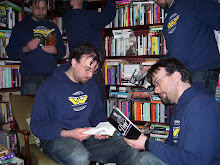An excellent introduction to his work is this New York Review of Books article by J. M. Coetzee (an aside: Coetzee lives a few minutes' walk from me, and when out walking his dog I sometimes go past his house. I have seen a Nobel Prize-winner's underpants (hanging on a washing-line, not being worn)). The article begins dramatically with Walser's death:
'On Christmas Day, 1956, the police of the town of Herisau in eastern Switzerland were called out: children had stumbled upon the body of a man, frozen to death, in a snowy field. Arriving at the scene, the police took photographs and had the body removed.
'The dead man was easily identified: Robert Walser, aged seventy-eight, missing from a local mental hospital. In his earlier years Walser had won something of a reputation, in Switzerland and even in Germany, as a writer. Some of his books were still in print; there had even been a biography of him published. During a quarter of a century in mental institutions, however, his own writing had dried up. Long country walks—like the one on which he had died—had been his main recreation.'
The book in English by which Walser is best known is Jakob von Gunten, ably translated by Christopher Middleton. It is the diary of a young male student at the odd Institute Benjamenta (another name by which the book is sometimes known). It first came to my attention as a NYRB classic:
.jpg)
The book has now been re-covered to fit the series redesign, and looks like this:
.jpg)
The original English edition is a lovely-looking thing. This scan is from Will at A Journey Round My Skull, who is lucky enough to own it:

Also startling is this Serpent's Tail edition, using a haunting and mysterious still from the 1995 movie version by the Quay brothers (a movie which is both startlingly beautiful and sporadically tedious).
.jpg)
Then there's this older Vintage US edition:
.jpg)
Here are a scattering of other editions, in a variety of languages. The first three use images of Walser himself on the covers.
.jpg)
.jpg)
.jpg)
.jpg)
.jpg)
.jpg)
.jpg)
.jpg)
.jpeg)
.jpg)
If you want to read more Walser (and why wouldn't you?), try The Assistant (new in Penguin Modern Classics) or his Selected Stories (also from NYRB, and shown here with another old Vintage US paperback).



And, just for the hell of it, here are some other funky old Walsers, most in the original German.
.jpg)
.jpg)





.jpg)
.jpg)
.jpg)




2 comments:
Wow, I'd never seen the cover of
"Big Little World" before.
I particularly like the series of Surkamp editions that feature details from paintings by Felix Vallotton.
I meant to mention this when Will posted that Walk and Other Stories cover on his blog: the figure in the image reminds me of Joshua Mosley's "Dread."
http://joshuamosley.com/dread/
Which is a nice coincidence considering connections between Walser and Rousseau ...
Sam
Yes, those Valloton paintings are beautiful, and fit his work well. Thanks for the link to Mosley's site: I hadn't heard of him before--the excerpts from that film are very intriguing. The effect of the scanned and animated sculptures is lovely.
Post a Comment